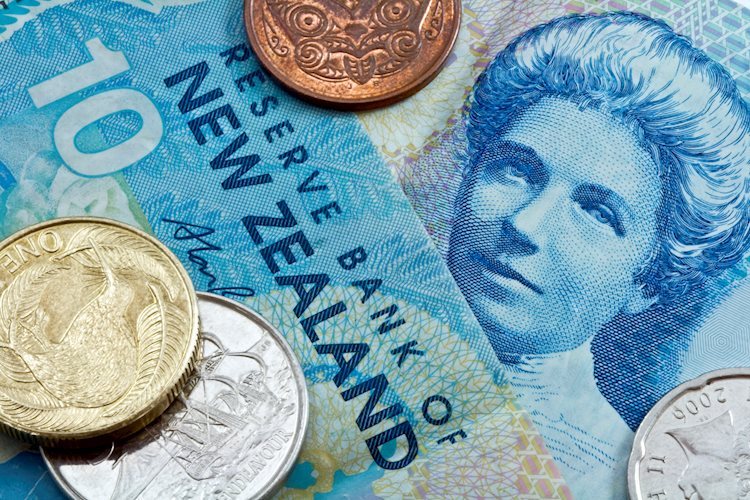- The New Zealand Dollar rises on increased optimism regarding its largest trading partner, China.
- The Kiwi gains after the US Dollar weakens and the PBOC decides to keep rates unchanged whilst pumping more liquidity into the economy.
- NZD/USD continues to rally. The medium-term outlook could now be bullish.
The New Zealand Dollar (NZD) benefits from an overall positive, risk-on mood in the markets on Tuesday. The US Dollar, meanwhile, remains pressured ahead of the release of the Federal Reserve’s last meeting minutes.
After Chinese central bank officials pledged to support the Chinese economy, optimism surrounding the outlook for New Zealand’s chief trading partner has remained strong.
The NZD/USD pair has broken above an important technical resistance level that has stubbornly held for over 3-months at 0.6050-0.6055 despite repeated attempts. If it can hold onto Tuesday’s gains, the break could be classed as ‘decisive’, shifting the intermediate outlook to bullish.
Daily digest market movers: New Zealand Dollar rises ahead of Fed minutes
- The New Zealand Dollar rises, benefiting from increased optimism over the outlook for China, its biggest trading neighbor.
- This suggests continued strong demand for Kiwi goods, which translates into increased demand for the currency, strengthening it.
- On Monday, People’s Bank of China (PBOC) officials reiterated their vow to roll out more policy support for the country’s beleaguered real estate sector.
- The PBOC also decided to leave its benchmark Loan Prime Rate (LPR) near record lows of 3.45%, further supporting the flow of easy credit.
- The US Dollar, on the other hand, continues to be weighed down by the expectation that the Federal Reserve (Fed) has concluded raising interest rates for this cycle and now sits at a pivotal turning point.
- Since higher interest rates tend to increase demand for a currency because they attract foreign capital inflows, this has weighed on USD.
- Markets are now pricing in the possibility of nearly 100 bps of Fed rate cuts by December 2024, which has led to a sharp decline in US Treasury bond yields, which are closely correlated with the USD. The yield on the benchmark 10-year US government bond fell to a two-month low on Friday and continues to undermine the US Dollar.
- The next major release for NZD/USD is the minutes from the November Federal Reserve meeting.
- This will provide analysts with more information regarding the Fed’s interest-rate setters and whether they concur with the market about the peak rate having been reached.
New Zealand Dollar technical analysis: NZD/USD breaks through key resistance level
NZD/USD – the number of US Dollars one New Zealand Dollar can buy – breaks above the key October highs at (0.6050 – 0.6055).
New Zealand Dollar vs US Dollar: Daily Chart
The pair remains in a short-term bullish trend, biasing longs. Since the break above the October highs, it may also now be deemed to be in a medium-term bullish trend too.
A decisive break above 0.6055 would change the outlook to bullish in the medium term, indicating the possibility of the birth of a new uptrend. Such a move would then initially target the 200-day Simple Moving Average (SMA) at around 0.6100.
If Tuesday’s daily candlestick closes green and on a bullish note, it will suggest more upside is probable.
A possible bullish inverse head and shoulders (H&S) pattern may have formed at the lows. The pattern is identified by the labels applied to the chart above. L and R stand for the left and right shoulders, whilst H stands for the head. The target for the inverse H&S is at 0.6215.
A decisive break would be one accompanied by a long green candle or three green candles in a row.
The long-term trend is still bearish, suggesting downside risks remain.
RBNZ FAQs
The Reserve Bank of New Zealand (RBNZ) is the country’s central bank. Its economic objectives are achieving and maintaining price stability – achieved when inflation, measured by the Consumer Price Index (CPI), falls within the band of between 1% and 3% – and supporting maximum sustainable employment.
The Reserve Bank of New Zealand’s (RBNZ) Monetary Policy Committee (MPC) decides the appropriate level of the Official Cash Rate (OCR) according to its objectives. When inflation is above target, the bank will attempt to tame it by raising its key OCR, making it more expensive for households and businesses to borrow money and thus cooling the economy. Higher interest rates are generally positive for the New Zealand Dollar (NZD) as they lead to higher yields, making the country a more attractive place for investors. On the contrary, lower interest rates tend to weaken NZD.
Employment is important for the Reserve Bank of New Zealand (RBNZ) because a tight labor market can fuel inflation. The RBNZ’s goal of “maximum sustainable employment” is defined as the highest use of labor resources that can be sustained over time without creating an acceleration in inflation. “When employment is at its maximum sustainable level, there will be low and stable inflation. However, if employment is above the maximum sustainable level for too long, it will eventually cause prices to rise more and more quickly, requiring the MPC to raise interest rates to keep inflation under control,” the bank says.
In extreme situations, the Reserve Bank of New Zealand (RBNZ) can enact a monetary policy tool called Quantitative Easing. QE is the process by which the RBNZ prints local currency and uses it to buy assets – usually government or corporate bonds – from banks and other financial institutions with the aim to increase the domestic money supply and spur economic activity. QE usually results in a weaker New Zealand Dollar (NZD). QE is a last resort when simply lowering interest rates is unlikely to achieve the objectives of the central bank. The RBNZ used it during the Covid-19 pandemic.
